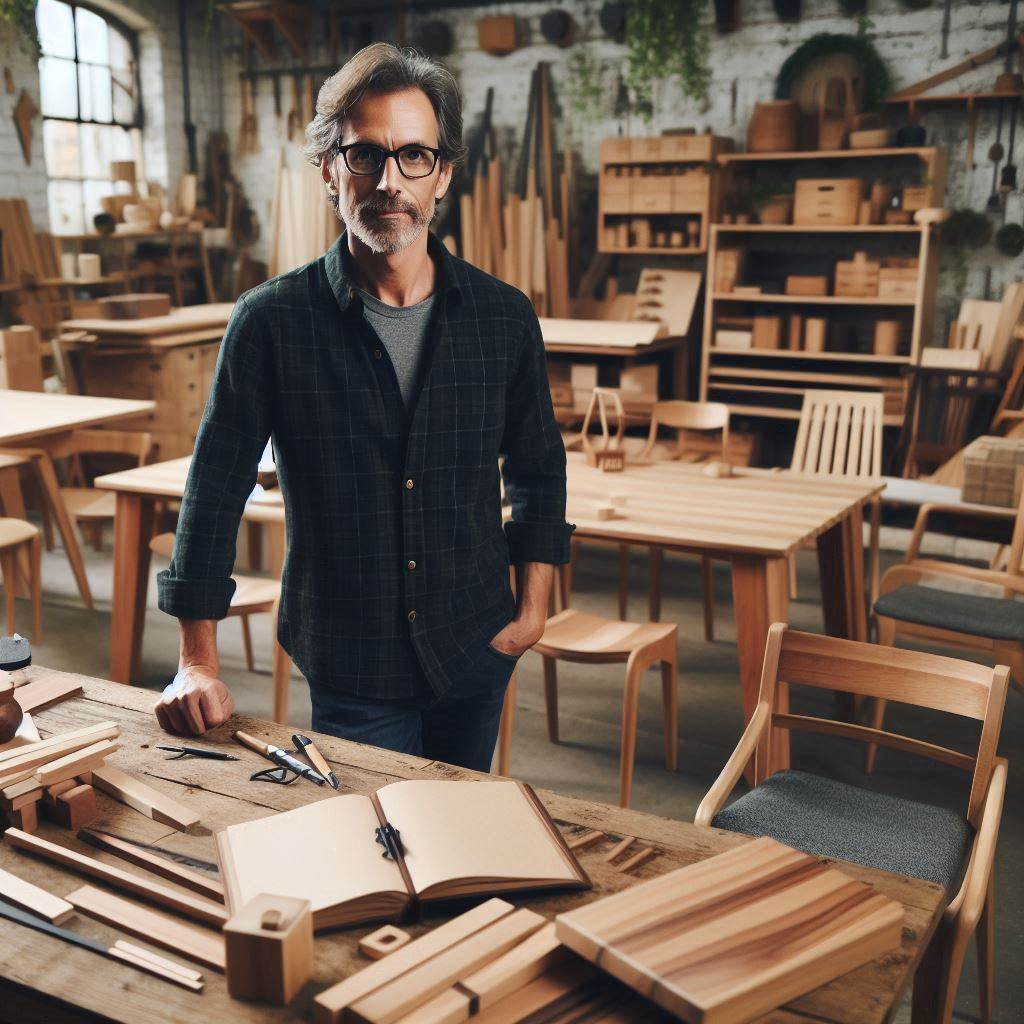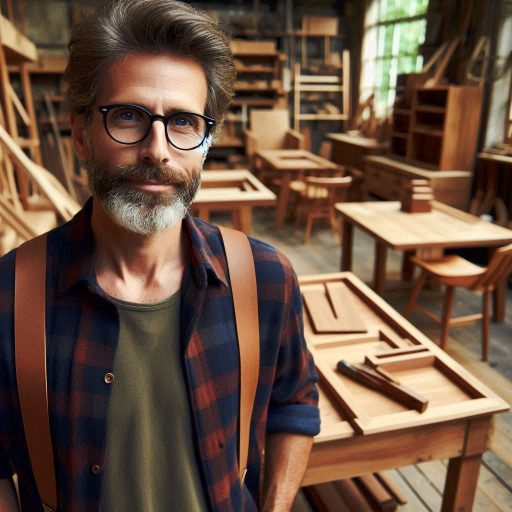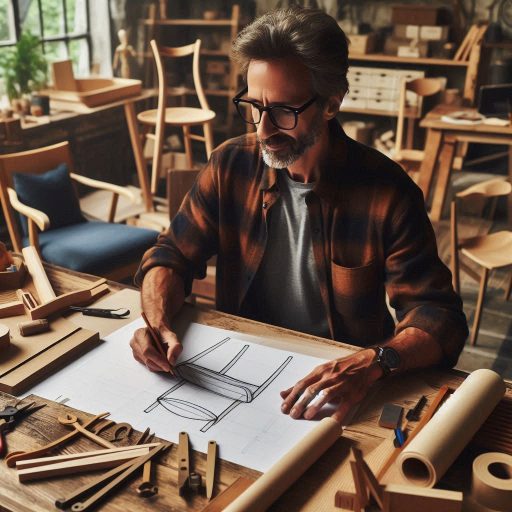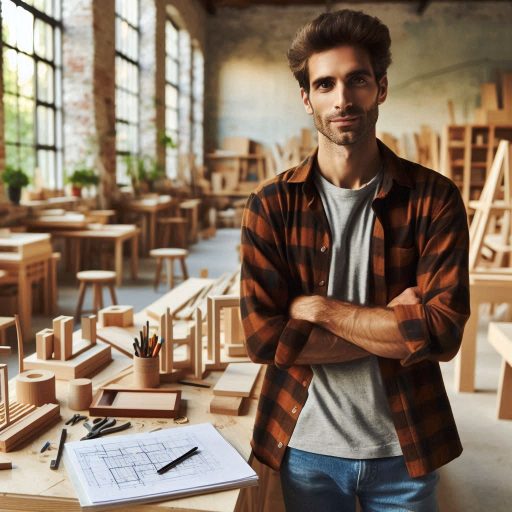Introduction
Are you a furniture designer looking to improve your craft? Having the right tools is essential for success.
From measuring and cutting to assembling and finishing, every step of the design process relies on having the proper equipment.
Let’s explore the impact that tools can have on creating stunning furniture pieces.
Selection of Tools
When it comes to furniture design, having the right tools can make all the difference.
A good set of measuring tools, such as a tape measure and angle finder, are essential for accuracy in design.
Quality cutting tools, like a table saw and jigsaw, ensure clean and precise cuts.
Importance of Tools
Without the right tools, furniture designers may struggle with accuracy and efficiency in their work.
Having the proper equipment not only improves the quality of the finished product but also saves time and effort during the design process.
Investing in good tools is an investment in the success of your designs.
Impact on Design Process
Imagine trying to build a piece of furniture without the necessary tools – it would be nearly impossible to achieve the desired result.
With the right tools at your disposal, you can bring your design ideas to life with precision and ease.
Tools empower designers to create functional and beautiful furniture pieces that meet the highest standards of craftsmanship.
Measuring Tools
The Importance of Accurate Measurements in Furniture Design
Accurate measurements are crucial in furniture design.
Without precise measurements, even the best ideas can fall apart.
Designers must ensure every piece fits perfectly within its intended space.
Whether creating a sleek modern chair or a custom-built cabinet, precision is key.
Measuring tools are indispensable in achieving this accuracy and maintaining consistency across designs.
Essential Measuring Tools Such as Tape Measures, Rulers, and Calipers
The most essential tool in a furniture designer’s kit is the tape measure.
Tape measures provide quick, reliable measurements for large-scale pieces, from sofas to dining tables.
Their flexibility allows designers to measure curved surfaces, helping them visualize how each component will fit together.
With a tape measure, designers can confidently translate their concepts into physical dimensions.
Rulers are another must-have for furniture designers.
Typically used for smaller components, they provide a stable, straight edge.
Rulers allow for precise measurements and ensure clean, straight cuts in materials like wood, metal, or fabric.
In furniture design, where a single millimeter can make a difference, rulers ensure accuracy in smaller dimensions and details.
Calipers are the go-to tool for measuring fine details.
Unlike tape measures or rulers, calipers can gauge thickness, depth, and inside dimensions.
They’re ideal for intricate work, such as fitting joinery or ensuring uniformity in parts like table legs or drawer fronts.
Calipers provide designers with an extra layer of precision, especially when working with multiple components that must fit seamlessly.
How Measuring Tools Can Ensure Precision and Consistency in Design
By using these tools, furniture designers ensure precision at every stage.
Accurate measurements help avoid costly errors during production.
A slight miscalculation can result in pieces that don’t fit, wasted materials, and lost time.
Having the right tools ensures these problems are minimized, helping designers stay efficient and cost-effective.
Consistency is another critical aspect of furniture design.
When producing multiple pieces or working on modular furniture, designers need to ensure that each component matches the next.
Measuring tools allow designers to maintain this consistency, from the first piece to the last.
Consistent measurements lead to high-quality furniture that looks professional and functions perfectly.
In short, measuring tools are essential for furniture designers to maintain accuracy, precision, and consistency.
Tape measures, rulers, and calipers offer different ways to measure various aspects of a design.
These tools ensure every piece is built to fit, resulting in furniture that is both functional and aesthetically pleasing.
When it comes to crafting beautiful, durable furniture, precise measurements make all the difference.
Read: Famous Costume Designers in Hollywood
Cutting Tools
The Significance of Cutting Tools in Shaping and Forming Furniture
Cutting tools play a crucial role in furniture design.
They allow designers to shape and form materials into functional and artistic pieces.
Precision in cutting directly influences the quality of the final product.
Whether working with wood, metal, or other materials, cutting tools are indispensable for creating custom designs and achieving clean, smooth edges.
Essential Cutting Tools Like Saws, Routers, and Chisels
Saws are one of the most commonly used cutting tools in furniture design.
There are many types of saws, each suited for different tasks.
Table saws help designers make straight cuts in large pieces of wood or panels.
Jigsaws are perfect for making curved or intricate cuts, giving designers the freedom to create unique shapes.
Bandsaws are another essential option, especially for making precise cuts in thick materials or for detailed, fine work.
Routers are another versatile tool in the cutting arsenal.
They allow designers to create smooth edges and intricate patterns on wood surfaces.
With a router, furniture designers can easily carve out grooves, trim edges, and create decorative features.
Routers are also useful for hollowing out areas in materials, making them a must-have for detailed woodworking projects.
Chisels are vital for more delicate cutting work and fine details.
They allow designers to sculpt and refine materials with precision.
Chisels come in various shapes and sizes, each designed for specific tasks like carving joints or intricate details.
Furniture designers often use chisels to create traditional woodworking joints, such as dovetails, which add both strength and aesthetic value to a piece.
Proper chisel work requires skill and practice, but it can elevate the quality of a finished product.
How Different Cutting Tools Are Used for Various Materials and Techniques
Different cutting tools are essential for different materials and techniques.
For example, saws are more suitable for large, straight cuts in wood, but when working with metal, specialized saws like hacksaws or metal-cutting bandsaws are more appropriate.
On the other hand, routers are more commonly used for detailed work on wood and plastic, while chisels are used across various materials, from wood to stone, depending on the project’s needs.
Essentially, cutting tools are an essential component of furniture design.
Designers rely on saws, routers, and chisels to transform raw materials into finished furniture.
By mastering these tools and knowing when to use each one, furniture designers can create stunning, precise, and durable pieces that reflect both functionality and creativity.
Read: Essential Skills for Aspiring Costume Designers
Joinery Tools
The Role of Joinery Tools in Connecting and Securing Furniture Pieces
Joinery tools play a crucial role in the furniture design process.
These tools connect and secure different components, ensuring the furniture’s durability and functionality.
Without proper joinery, even the most aesthetically pleasing designs would fail to stand the test of time.
Essential Joinery Tools Such as Drills, Screws, Nails, and Glue
One essential joinery tool is the drill.
Drills help create precise holes for screws, dowels, or other fasteners.
These holes ensure a snug fit, strengthening the connection between parts.
Drills can also be used with various bits for different materials, making them versatile in any workshop.
Screws are another vital joinery tool.
They provide a firm, adjustable bond between furniture components.
Unlike nails, screws allow for easy disassembly and reassembly if necessary, offering flexibility during repairs or modifications.
The threads of a screw grip the material tightly, preventing movement and maintaining the piece’s structural integrity.
Nails, while simpler than screws, offer quick and strong fastening.
They are especially useful in securing pieces that won’t require disassembly.
Nails penetrate the material deeply, providing a tight bond that holds components in place.
In traditional woodworking, nails are often used alongside glue to increase stability.
Glue is another indispensable joinery tool, bonding materials together without the need for fasteners.
It provides a seamless connection that is often invisible, enhancing the aesthetic of the finished product.
Wood glue, in particular, penetrates fibers and forms a strong bond, making it ideal for wood-based furniture designs.
However, the glue needs time to set, so clamps are often used to hold the pieces in place while the glue dries.
How Joinery Tools Contribute to the Structural Integrity of Furniture Designs
These joinery tools collectively contribute to the structural integrity of furniture.
When used correctly, they ensure the furniture can withstand daily use and maintain its form over time.
Joinery tools don’t just connect materials; they also enhance the overall strength and durability of the design.
Strong joints prevent wobbling, cracking, or separation, which can occur in poorly constructed furniture.
Whether you’re crafting a simple chair or an intricate bookshelf, the right joinery tools help secure every element in place.
This foundation of sturdy connections allows furniture to endure the weight, stress, and motion it faces during use.
In fact, drills, screws, nails, and glue are all critical joinery tools in furniture design.
They ensure a solid, lasting connection between parts, contributing to the furniture’s strength and longevity.
Proper use of these tools guarantees that your furniture pieces are not only beautiful but built to last.
Read: Visual Merchandiser: Job Market and Opportunities

Finishing Tools
The Importance of Finishing Tools in Enhancing the Appearance of Furniture
Finishing tools play a vital role in the final stages of furniture design.
They enhance the visual appeal and ensure durability.
These tools give furniture pieces their polished look, adding depth and character that bare materials cannot achieve.
The right finishing tools transform ordinary wood into something truly unique.
They smooth surfaces, eliminate imperfections, and prepare the material for treatment.
A sleek, even finish allows designers to elevate their work from raw to refined.
Essential Finishing Tools like Sandpaper, Brushes, and Finishes
Sandpaper, for instance, smooths surfaces, preparing the material for the next stage of treatment.
By eliminating rough edges and imperfections, sandpaper ensures that paint, stain, or varnish adheres evenly and looks professional.
Brushes are another critical finishing tool.
They apply stains, paints, or varnishes with precision, allowing designers to add color and texture to their work.
Brushes help control the amount of finish applied, ensuring the perfect balance between too much or too little product.
Finishes such as varnish, lacquer, or wax provide a protective layer that shields the wood from moisture, scratches, and wear.
They also bring out the natural tones of the material, highlighting its beauty.
How Finishing Tools Can Add Texture, Color, and Protection to Furniture Designs
Finishing tools help furniture designers create texture.
The type of brush or application tool used can determine the texture and overall feel of the surface.
A coarse brush creates a rustic, textured appearance, while a finer brush results in a smooth finish.
Designers can experiment with different tools to craft unique tactile experiences.
In addition to adding texture, finishing tools allow designers to play with color.
Stains, paints, and dyes enable designers to personalize their furniture, bringing their artistic vision to life.
A well-chosen finish can transform a simple piece into a bold, statement-making work of art.
Finally, finishing tools provide crucial protection.
By using the right finishes, designers ensure their furniture withstands the test of time.
They combine aesthetics and functionality, making finishing tools an indispensable part of furniture creation.
Read: Visual Merchandising: Best Practices for Beginners
Transform Your Career Today
Unlock a personalized career strategy that drives real results. Get tailored advice and a roadmap designed just for you.
Start NowDesign Software
Introduce the Concept of Design Software in Modern Furniture Design
In modern furniture design, using design software has become essential for creating innovative and precise designs.
Furniture designers rely on advanced digital tools to streamline their workflows and produce more detailed, accurate, and customizable products.
These software tools enable designers to move beyond traditional sketches, giving them the ability to build digital models and visualize designs in 3D.
The Benefits of Using Software for 3D Modeling and Visualizing Designs
The benefits of design software for furniture designers are vast.
One of the key advantages is the ability to create 3D models, which provide a more comprehensive view of the design.
These models allow designers to explore various angles, make adjustments, and refine details without the need for physical prototypes.
This leads to significant time and cost savings, as changes can be made digitally before moving to the production phase.
Additionally, design software helps furniture designers communicate their ideas more effectively with clients.
Visualizing designs in 3D gives clients a clear understanding of the final product.
This reduces the chances of miscommunication and ensures that the designer and client are on the same page throughout the process.
Moreover, clients can offer feedback early, allowing designers to make adjustments before any materials are wasted.
Beyond visualization, design software enhances precision in design.
Furniture pieces often require complex measurements and intricate detailing, and software tools make this process much easier.
Designers can input exact dimensions and create perfectly scaled models, reducing the likelihood of errors during production.
This level of accuracy is crucial, especially for custom furniture where every detail matters.
Recommend Popular Design Software Tools Used by Furniture Designers
Several software tools have become popular among furniture designers.
One of the most widely used is AutoCAD, which allows designers to create both 2D and 3D designs with precise measurements.
Another excellent tool is SketchUp, known for its user-friendly interface and flexibility in 3D modeling.
SketchUp’s extensive library of pre-made furniture models also saves designers valuable time.
Rhino is another powerful option, offering advanced 3D modeling and rendering capabilities, making it ideal for more complex projects.
For designers focused on creating photorealistic visuals, Blender is a great choice.
It provides detailed rendering features that bring furniture designs to life with realistic textures and lighting.
SolidWorks is another robust software, particularly favored for its engineering-grade design tools, which are perfect for producing technical furniture models that require precision and durability.
Overall, design software plays a pivotal role in modern furniture design.
These tools offer unparalleled flexibility, accuracy, and efficiency, making them indispensable for today’s furniture designers.
Safety Gear
Stress the Necessity of Safety Gear in a Furniture Design Workshop
Safety gear is crucial in any furniture design workshop.
Designers often work with sharp tools and heavy materials.
Protecting yourself from potential hazards should be a priority.
Wearing the right safety equipment prevents accidents and minimizes risks.
Here’s a look at the essential safety gear every furniture designer should use.
Essential Safety Gear
First, goggles are indispensable.
They shield your eyes from dust, debris, and flying particles.
When cutting or sanding materials, goggles help prevent serious eye injuries.
Always choose goggles that fit well and offer proper coverage.
You want to ensure they stay in place while you work.
Next, gloves are a must-have.
They protect your hands from cuts, scrapes, and splinters.
Different types of gloves offer various levels of protection.
Consider using cut-resistant gloves when handling sharp tools.
Leather gloves provide durability, while latex or nitrile gloves guard against chemicals.
Choose gloves that suit the specific tasks you’ll perform.
Ear protection is another key piece of safety gear.
Workshops can be noisy, especially when using power tools.
Prolonged exposure to loud sounds can damage your hearing.
Invest in quality earplugs or earmuffs to reduce noise levels.
Wearing ear protection helps you focus on your work without distractions.
Dust masks or respirators are vital for respiratory protection.
When sanding or cutting materials, dust particles can become airborne.
Breathing in this dust can lead to health issues over time.
A dust mask filters harmful particles, while a respirator provides more robust protection.
Make sure to select the right type based on the materials you’re using.
Additionally, a sturdy apron or work shirt protects your body and clothing.
Choose an apron made of durable material that can withstand wear and tear.
It keeps you safe from spills and debris, allowing you to work freely.
Look for aprons with pockets for easy access to tools and supplies.
Finally, non-slip footwear is essential.
A workshop floor can be hazardous, especially with sawdust or spilled materials.
Wearing shoes with good grip prevents slips and falls.
Opt for closed-toe shoes that provide both comfort and protection.
How Safety Gear Can Prevent Accidents and Protect Designers from Harm
In a nutshell, safety gear is not optional; it’s necessary.
Using goggles, gloves, ear protection, dust masks, aprons, and non-slip footwear creates a safer workspace.
By prioritizing safety, furniture designers can focus on their creativity and craftsmanship.
Protecting yourself is the first step toward successful and enjoyable design work.
Stay safe, and keep designing!
Storage and Organization Tools
The Importance of Storage and Organization Tools in Maintaining a Tidy Workspace
In furniture design, maintaining a tidy workspace is essential for creativity and efficiency.
A cluttered environment can hinder your focus and disrupt your workflow.
Storage and organization tools play a crucial role in achieving a clean and functional workspace.
These tools help you store materials, tools, and equipment systematically, making everything easily accessible.
Essential Tools Like Storage Bins, Shelves, and Toolboxes
Storage bins are vital for organizing small items.
They come in various sizes and can accommodate different materials.
Use clear bins to quickly identify contents without opening them.
Labeling bins enhances efficiency, allowing you to find items at a glance.
Bins also prevent materials from getting mixed up, reducing waste and saving time.
Shelves are another essential storage solution.
They provide vertical storage options, freeing up floor space.
Use shelves to display tools, materials, and finished pieces.
A well-organized shelf allows you to quickly locate items you need for your projects.
Additionally, shelves can enhance the aesthetic of your workspace, reflecting your design style.
Toolboxes offer a portable solution for organizing tools.
They keep your tools secure and easy to transport.
Choose toolboxes with compartments to separate different tools and accessories.
This organization helps you avoid wasting time searching for the right tool when you need it.
A well-stocked toolbox ensures that you have everything at hand, increasing productivity.
How Proper Storage and Organization Can Improve Efficiency and Workflow in Furniture Design
Proper storage and organization lead to improved efficiency in furniture design.
When your workspace is organized, you can focus more on the creative process.
You’ll spend less time managing clutter and more time designing.
An organized space allows for a smoother workflow, enabling you to transition from one task to another seamlessly.
In addition, an organized workspace promotes safety.
When tools and materials are stored correctly, you reduce the risk of accidents.
A clutter-free environment allows for clear movement and helps prevent injuries.
This safety aspect is crucial in a profession that often involves sharp tools and heavy materials.
Investing in storage and organization tools pays off in the long run.
It helps you create a workspace that fosters creativity and productivity.
As you design furniture, an organized environment enhances your ability to innovate.
With everything in its place, you can focus on transforming your ideas into reality.
Most importantly, effective storage and organization tools are indispensable for furniture designers.
They maintain a tidy workspace, improve efficiency, and enhance safety.
By utilizing bins, shelves, and toolboxes, you can create an organized environment that supports your design endeavors.
Prioritize organization, and watch your productivity soar!
Conclusion
In furniture design, the right tools make all the difference.
This blog highlighted essential categories of tools for designers: measuring, cutting, finishing, and design software.
Each tool plays a crucial role in transforming ideas into reality.
Measuring tools ensure accuracy in every project.
Precise measurements lead to well-fitting components and harmonious designs.
Cutting tools shape materials with precision, allowing designers to create unique forms.
Finishing tools enhance the final appearance, adding texture and color that elevate designs.
Meanwhile, design software streamlines the process, enabling 3D modeling and visualization of concepts.
Investing in these essential tools can significantly improve your furniture design projects.
Quality tools not only enhance craftsmanship but also foster creativity.
They empower designers to push boundaries and explore innovative ideas.
The right tools give you confidence in your work, allowing you to focus on creativity rather than frustration.
Remember, the impact of having the proper tools extends beyond aesthetics.
It influences functionality, durability, and user satisfaction.
Well-designed furniture that meets these criteria stands out in a competitive market.
It attracts customers and enhances your reputation as a designer.
[E-Books for Sale]
The Big Book of 500 High-Paying Jobs in America: Unlock Your Earning Potential
$19.99 • 500 High-Paying Jobs • 330 pages
Explore 500 high-paying jobs in America and learn how to boost your career, earn more, and achieve success!
See All 500 High-Paying Jobs of this E-Book
1001 Professions Without a Degree: High-Paying American Jobs You Can Start Now
$19.99 • 1001 Professions Without a Degree • 174 pages
Discover 1001 high-paying jobs without a degree! Unlock career tips, skills, and success strategies for just $19.99!




